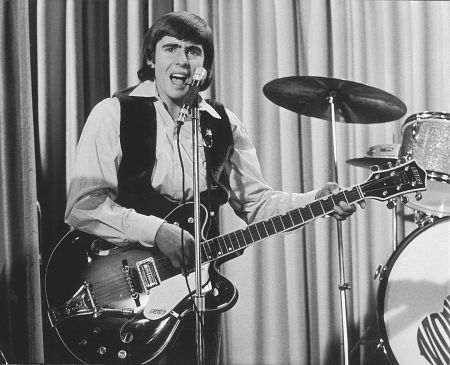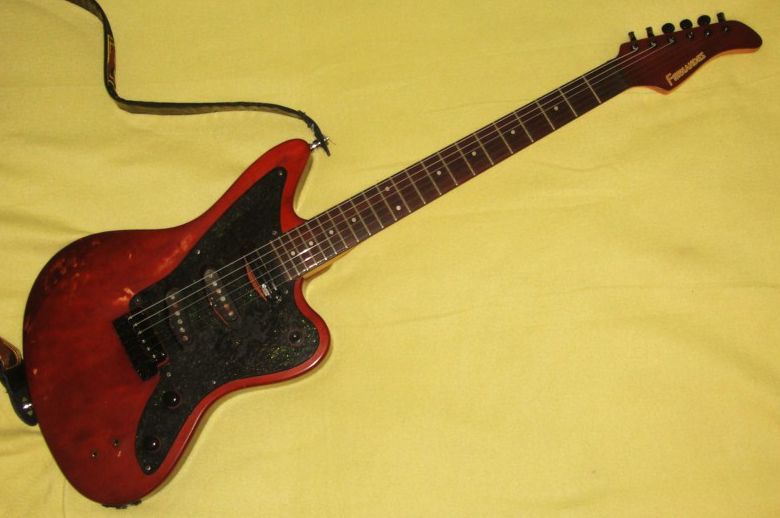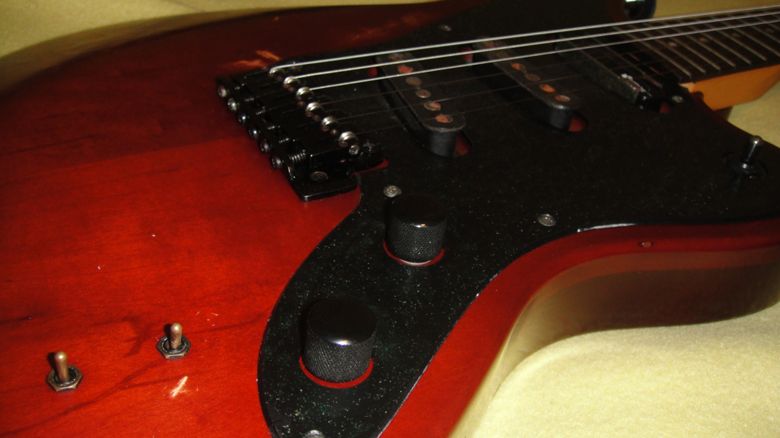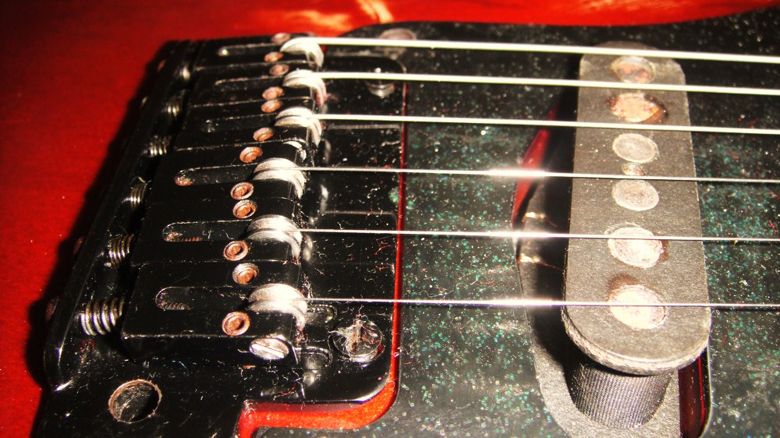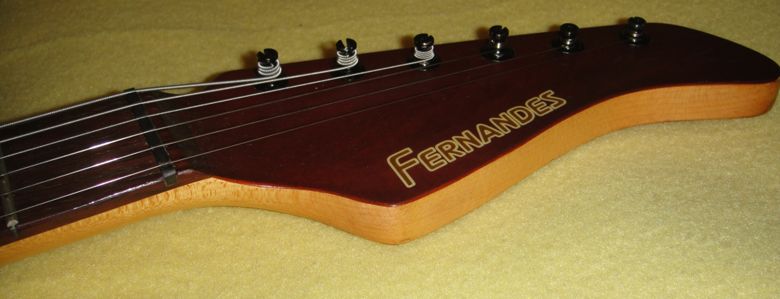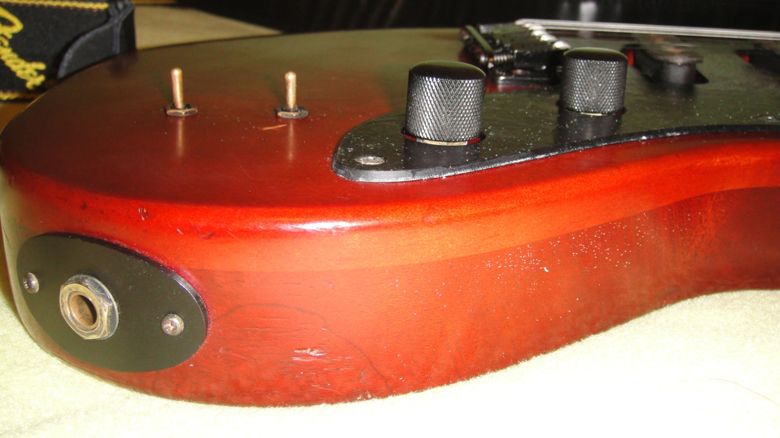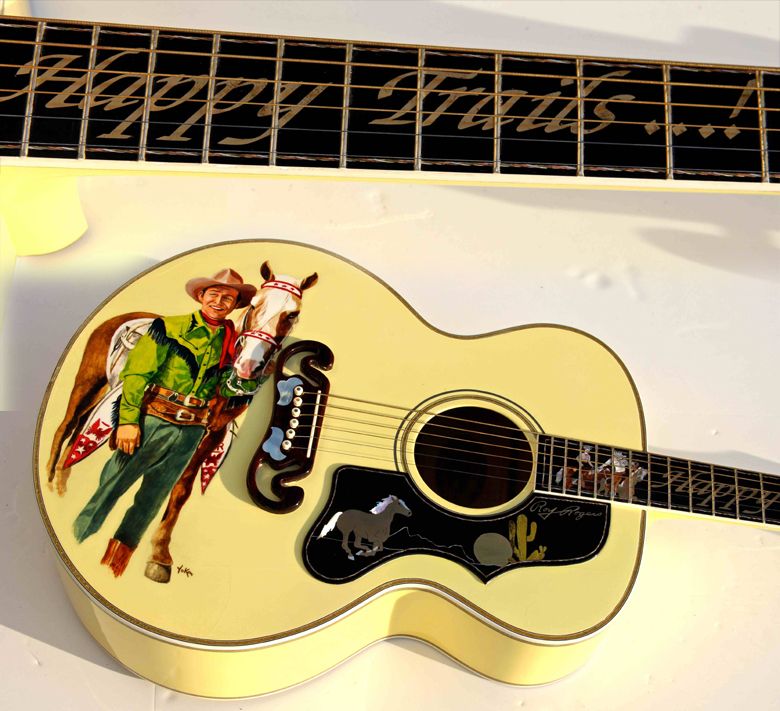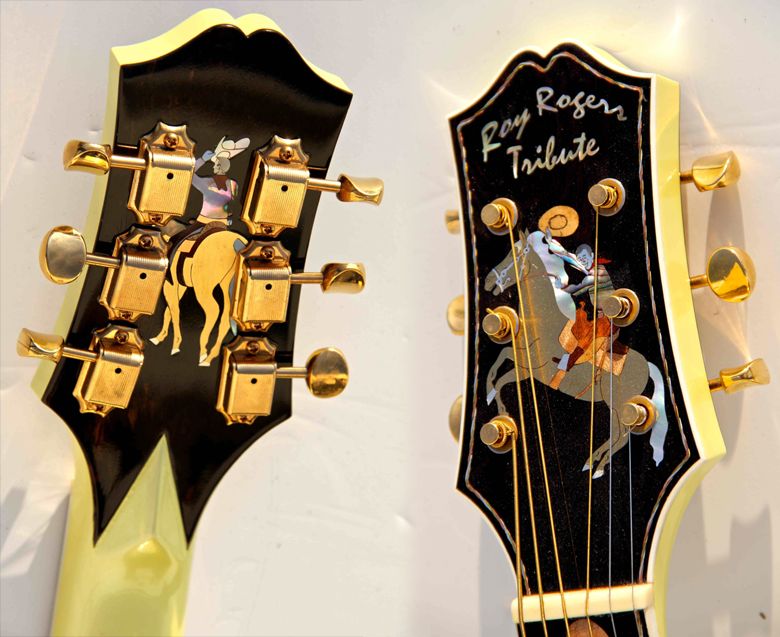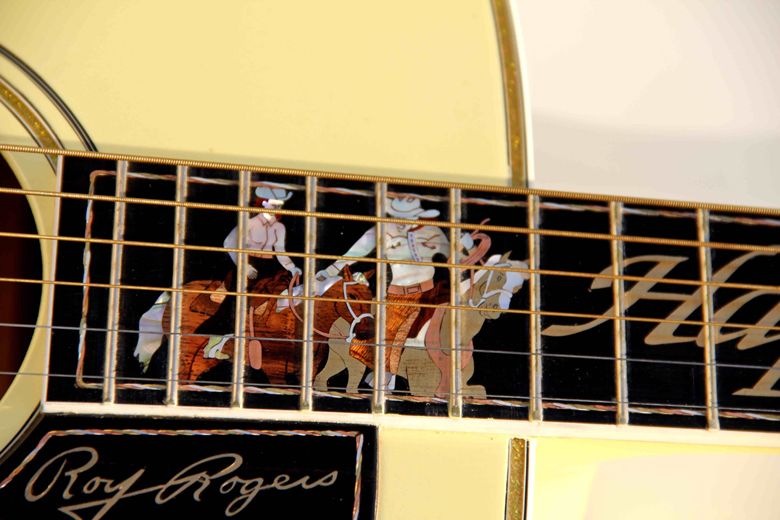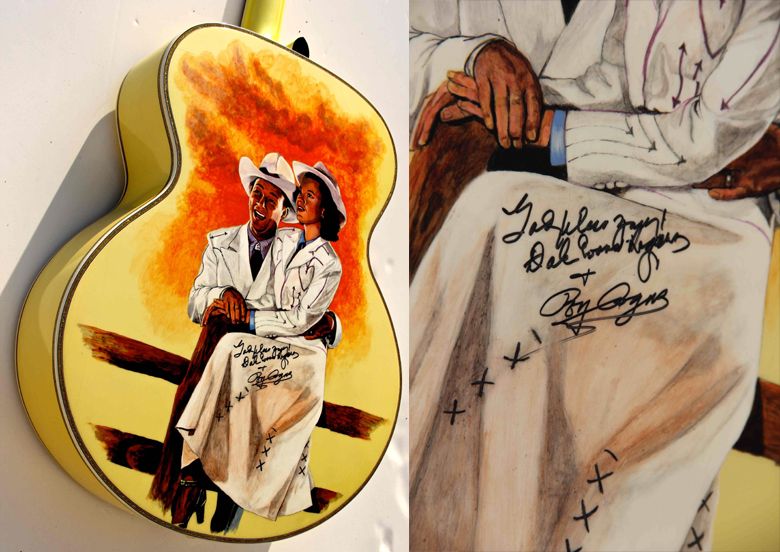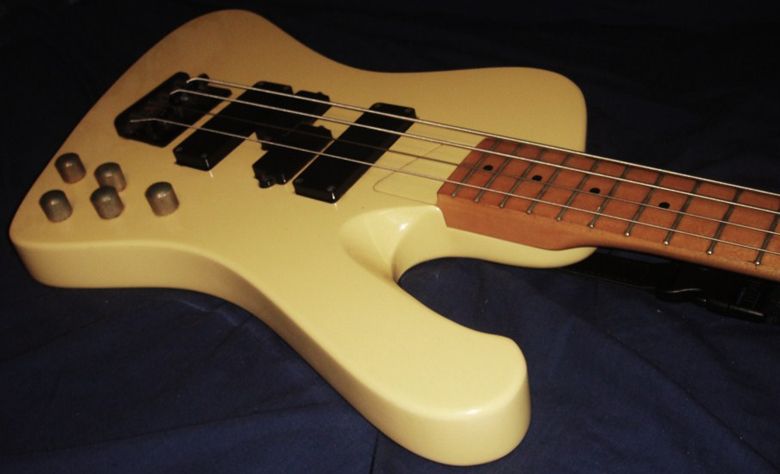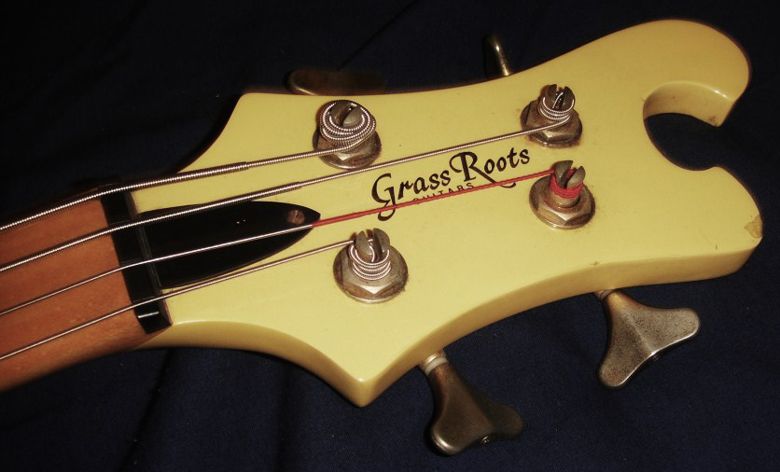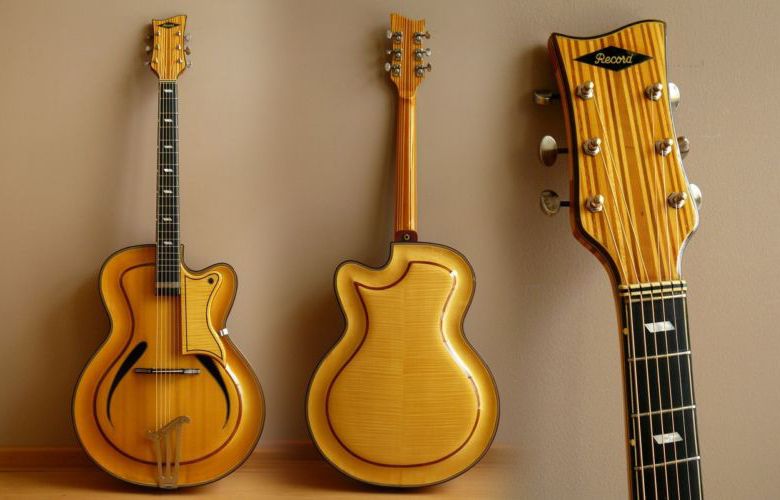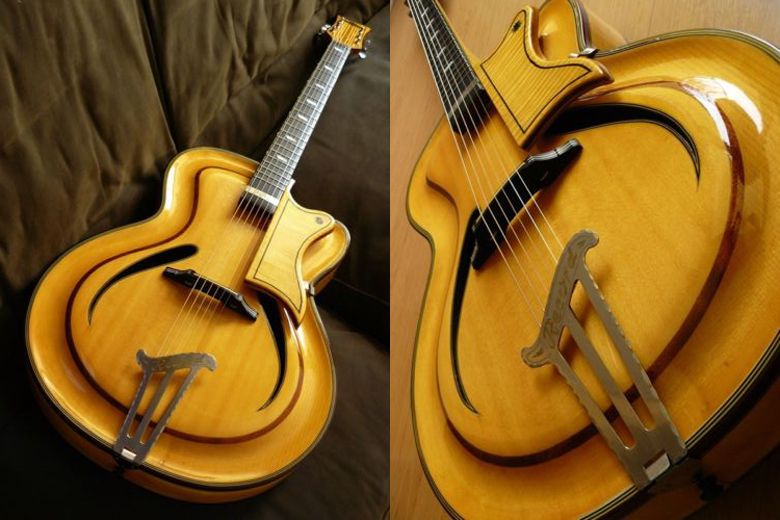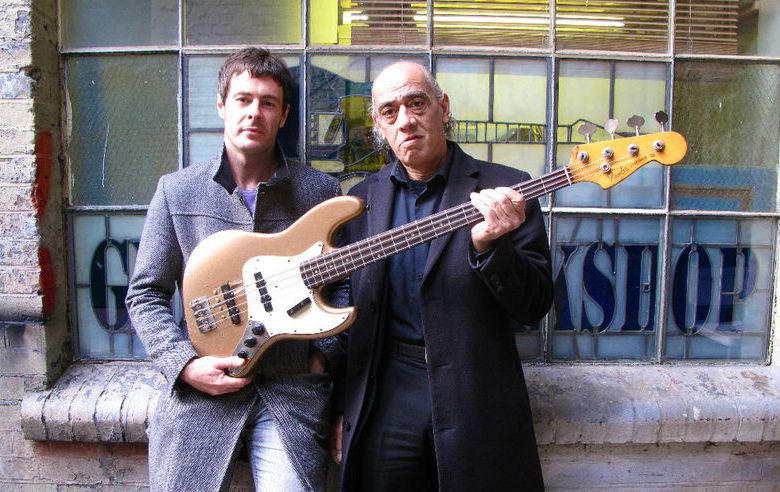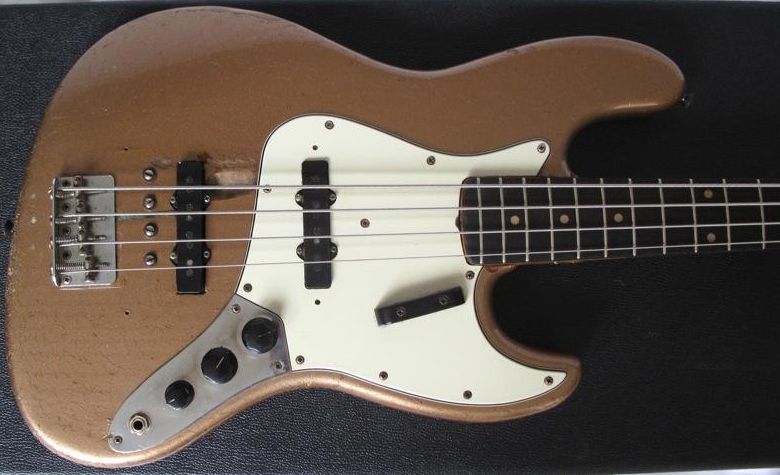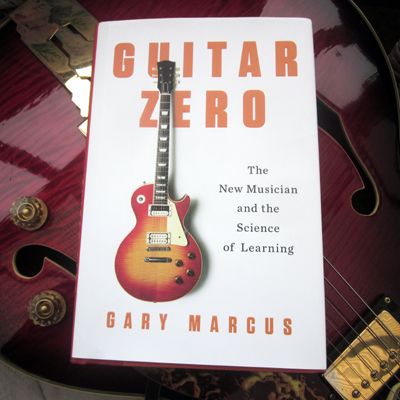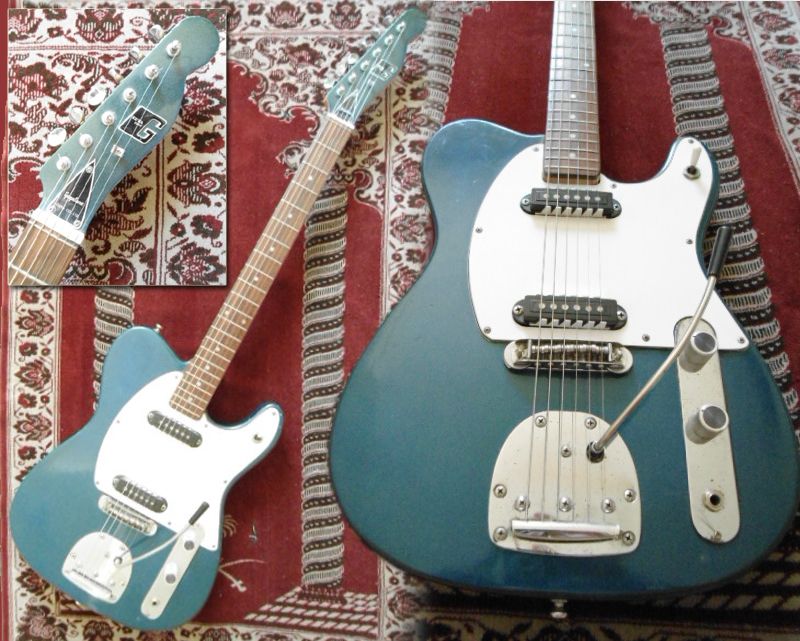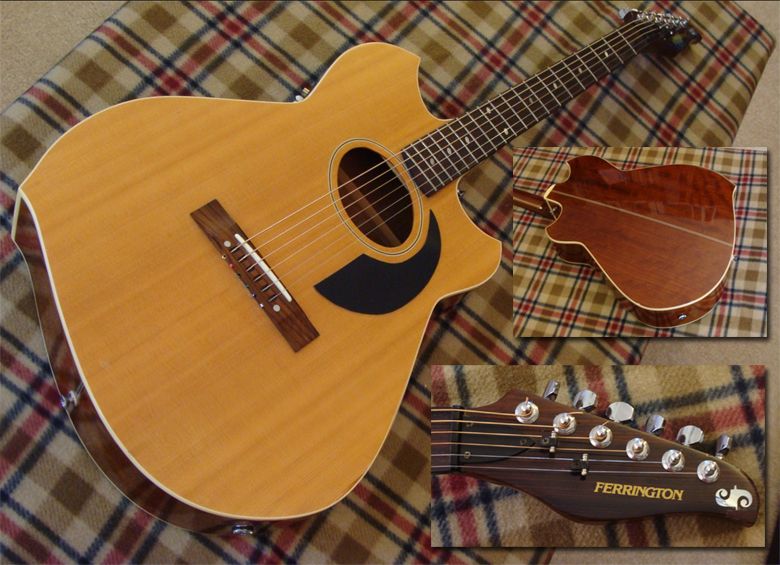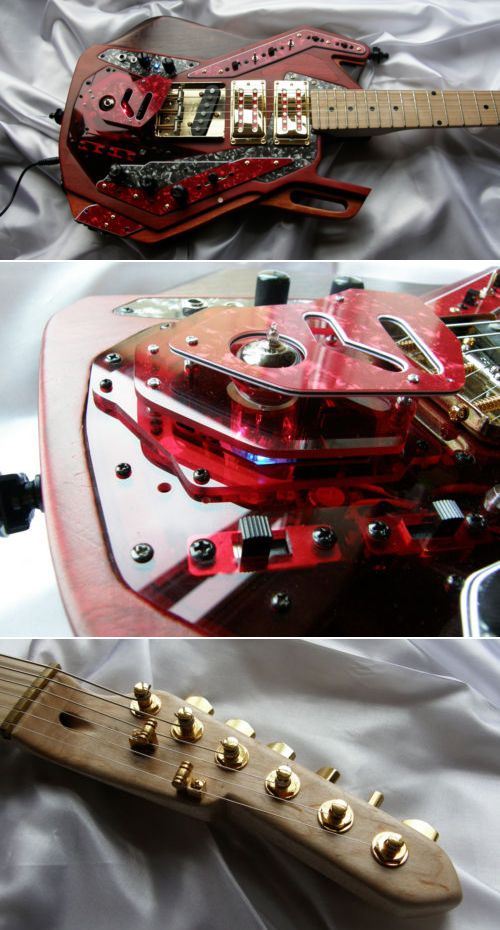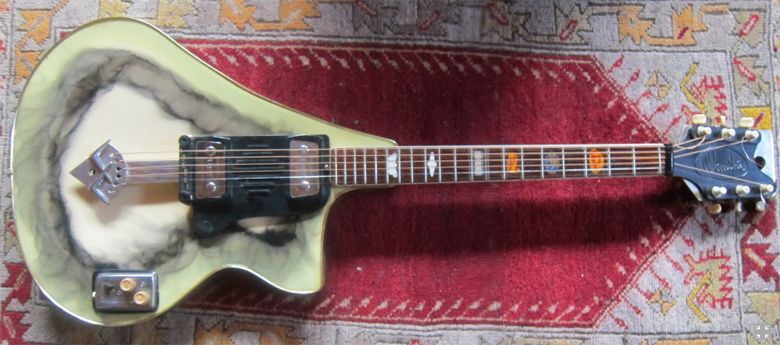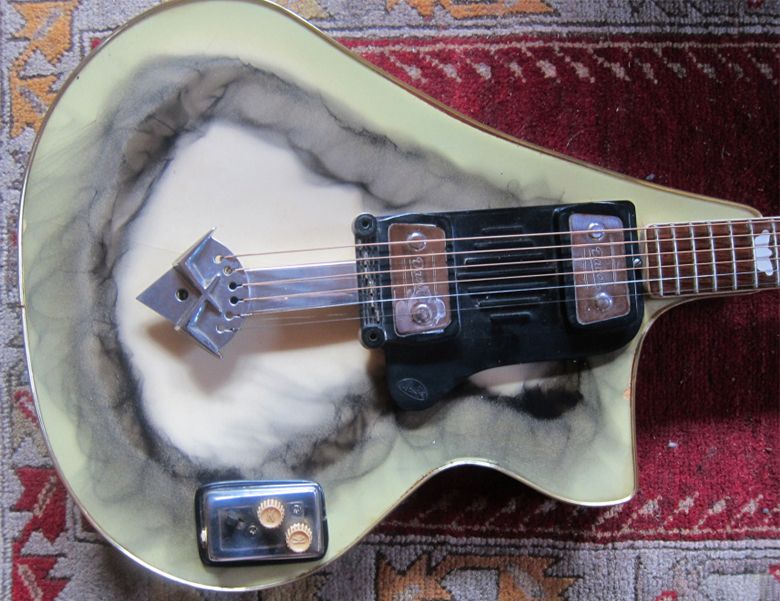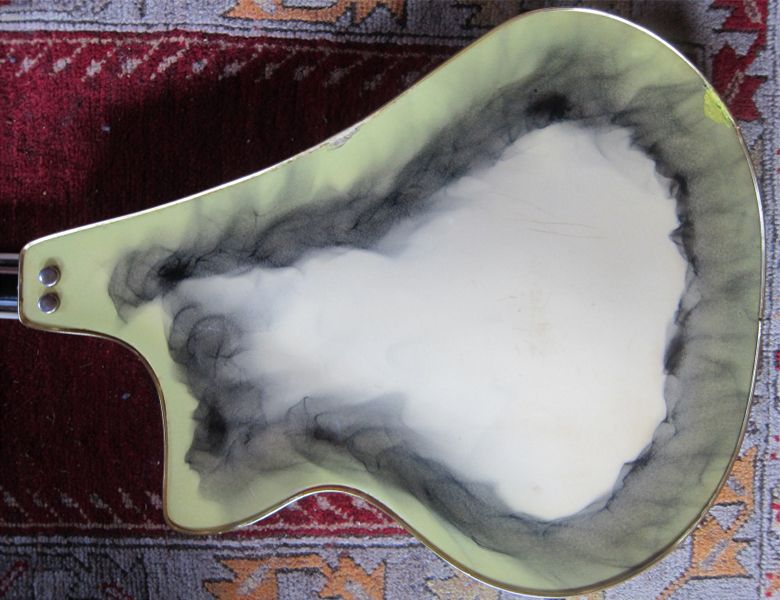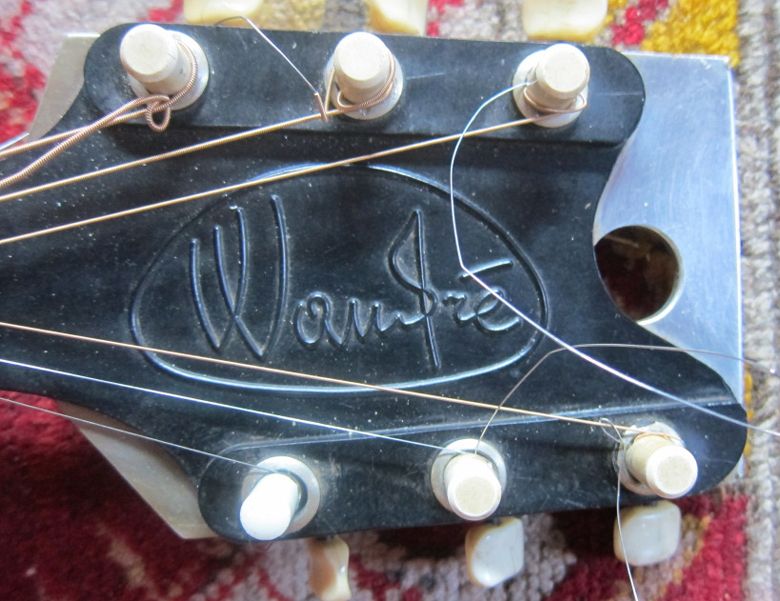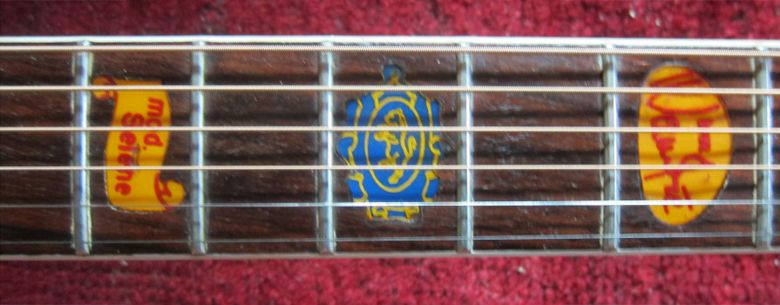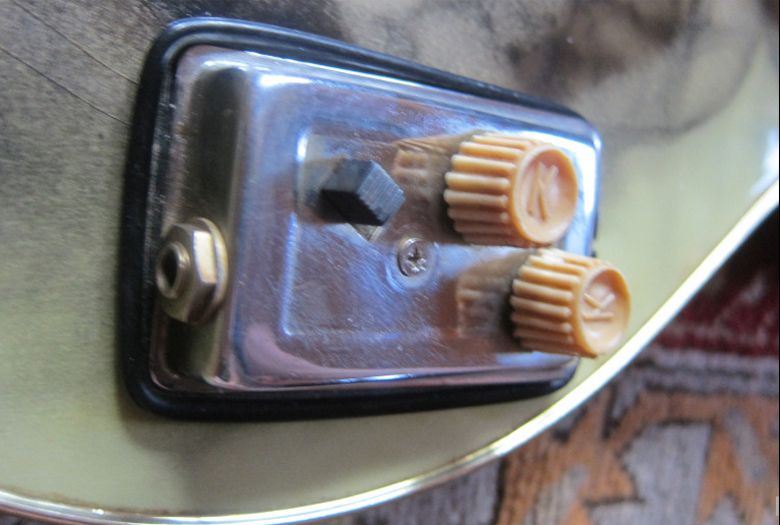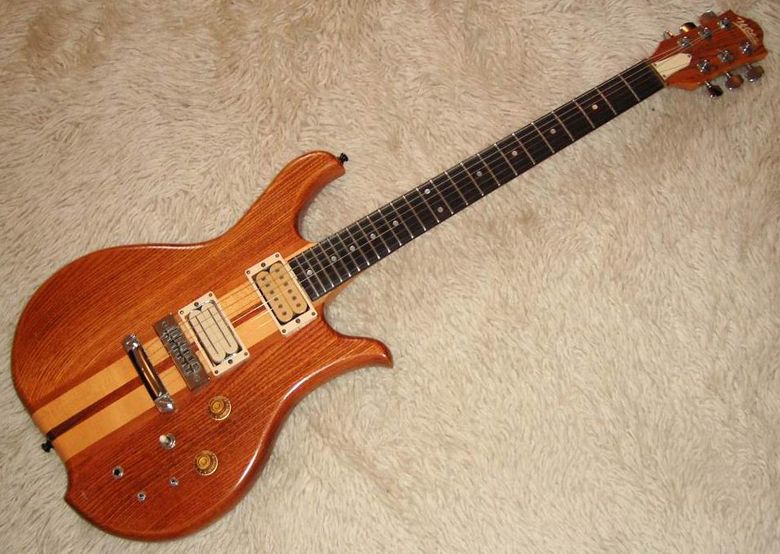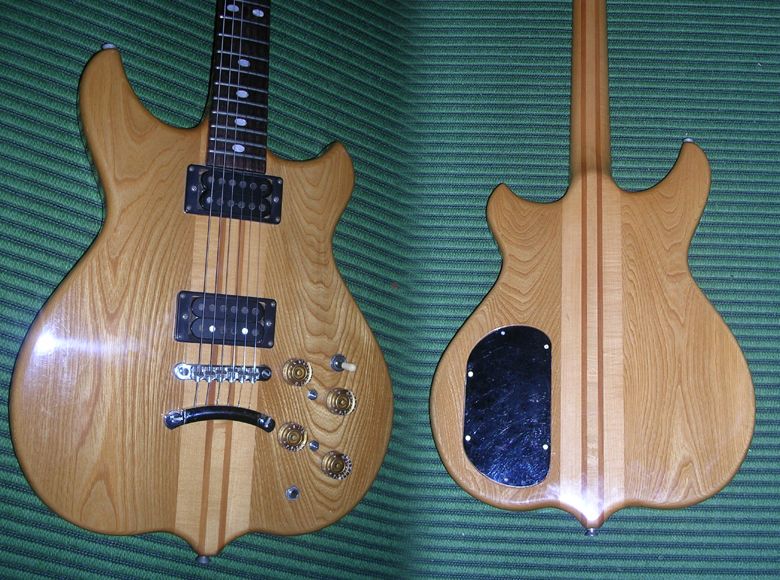guitarz.blogspot.com:
More sad news, I'm afraid. Davy Jones, famous as being "the British one" in 1960s manufactured pop band The Monkees, has passed away in his Florida home, aged 66. [BBC News story]
Although occasionally seen with a guitar or bass on The Monkees TV show (courtesy of Gretsch who supplied instruments for the programme), Jones wasn't particularly known as a guitarist, but in fact all four Monkees - Jones along with Peter Tork, Mickey Dolenz and Mike Nesmith were very musical.
They rebelled against their management's insistence that Monkees records should be made by session musicians and feature only one Monkee at a time on lead vocals (usually Jones or Dolenz), and on later albums they gained artistic control, playing their own instruments and writing the songs.
G L Wilson
© 2012, Guitarz - The Original Guitar Blog - now in its 10th year!
Wednesday, 29 February 2012
Fernandes JG-series Made In Japan Jazzmaster-esque offset-waist guitar with Sustainer
guitarz.blogspot.com:
Francis writes:
You mention that the guitar has three single-coil pickups and a three-way toggle switch. Surely three pickups are usually selected via a five-way toggle. (Not on early Fender Stratocasters, I know, before anyone comments). I suspect that the neck pickup is not a pickup at all, but is purely a sustainer unit. This would make sense with the three-way switch, as there are only actually two pickups to select.
Later Fernandes Sustainers have dual sustainer and pickup functions on the unit in the neck position; I have owned three Fernandes Sustainer guitars over the years and I always thought that the later combined sustainer/pickup units were rather weak. The current Fernandes that I own, like yours, is an older Japanese-made example and appears to be a three pickup guitar (albeit with a humbucker in the bridge position), but actually only has two pickups - with a three-way switch - and a dedicated Sustainer ONLY unit in the neck pickup position. The particular Fernandes guitar I am talking about is the only one I have ever tried that wasn't a disappointment. It's my personal belief that the earlier Fernandes Sustainers were the best. (Incidentally, didn't I read somewhere that the very earliest Fernandes guitars with the sustain feature used the Sustainiac rather than their own proprietary system?)
Anyway, despite all that I still prefer the EBow!
G L Wilson
© 2012, Guitarz - The Original Guitar Blog - now in its 10th year!
Francis writes:
I'm glad to see that the Guitarz crew take the time to listen to their readership. Thank you for featuring the Grass Roots bass, by the way. I was finally able to identify it thanks to a comment by a fellow reader!Hi Francis, thanks for showing us another one from your collection. It interesting to note some of the features on this guitar. For example, the spaces around the pickups and volume and tone controls in the pickguard. The Pickups and pots are not mounted on the guard as on Fender guitars; it looks like the pickguard is only there for aesthetics. This is reinforced by the fact that there is a plate covering the control cavity on the back of the guitar. Some would say this is messy, having plates on the front AND back of a guitar. Me, I think it just makes it all the more curious.
Anyway, here's a treat for you since you seem to be interested in Japanese guitars. Fernandes have been known for their takes on the Fender shape and have remained in the business producing non-lawsuit guitars well after the time of those old Fernandes/Burny copies. This particular guitar is part of the Fernandes JG series. Their spin on Fender's offset guitars. I'm not too sure about which came first but the Fernandes JG came out around 1996, right when Fender put out the Jagmaster as part of Squier's Vista series.
This model didn't appear on any of the catalogs Fernandes have on the internet. It has three single-coil pickups, a two-point tremolo bridge with roller saddles, a three-way toggle switch by the lower horn instead of the blade switch usually found on the Fernandes JGs and no tone knob. This also features a Fernandes Sustainer pickup, but not the same one found on their Sustainer Lite-series JGs. The two knobs are for guitar volume and Sustainer intensity. The two toggle switches below the knobs are to switch between regular and some other harmonic feedback setting or something, the other switch is for the Sustainer pickup.
This is a mix of all the features found on their various JG models. Something I was unable to find in their regular catalog. Eventually, I stumbled unto this Japanese site that lists two finishes with identical features as the Fernandes JG-85s EV. One has the regular black finish with weird pearloid-type pickguard found on the other JG models. The other one was this, what appears to be a transparent finish that shows the guitar's grains. A higher-end (well, it's around $1000, a bit more than the usual $500++) model JG, most likely a signature model for this band called Eins Vier (hence the EV in the model name).
I have questions for the readers though. I still don't know everything about this guitar. Does anyone have one? If so, what pots are in this? I could check mine but it could be possible that they could've been swapped out. Also, if you see that grain/top, could anyone identify what wood this is? I'm not that adept at identifying wood by grain. Thanks, if ever! Just sharing what information I have about an underrated guitar that has little to no information floating around the internet.
Francis
You mention that the guitar has three single-coil pickups and a three-way toggle switch. Surely three pickups are usually selected via a five-way toggle. (Not on early Fender Stratocasters, I know, before anyone comments). I suspect that the neck pickup is not a pickup at all, but is purely a sustainer unit. This would make sense with the three-way switch, as there are only actually two pickups to select.
Later Fernandes Sustainers have dual sustainer and pickup functions on the unit in the neck position; I have owned three Fernandes Sustainer guitars over the years and I always thought that the later combined sustainer/pickup units were rather weak. The current Fernandes that I own, like yours, is an older Japanese-made example and appears to be a three pickup guitar (albeit with a humbucker in the bridge position), but actually only has two pickups - with a three-way switch - and a dedicated Sustainer ONLY unit in the neck pickup position. The particular Fernandes guitar I am talking about is the only one I have ever tried that wasn't a disappointment. It's my personal belief that the earlier Fernandes Sustainers were the best. (Incidentally, didn't I read somewhere that the very earliest Fernandes guitars with the sustain feature used the Sustainiac rather than their own proprietary system?)
Anyway, despite all that I still prefer the EBow!
G L Wilson
© 2012, Guitarz - The Original Guitar Blog - now in its 10th year!
Tuesday, 28 February 2012
Vintage & Rare guitar of the week: Roy Rogers and Dale Evans jumbo acoustic
guitarz.blogspot.com:
Currently being sold by The Guitar Doctor, USA via Vintage & Rare is this Roy Rogers and Dale Evans Jumbo Art Tribute Guitar by Greg Rich, and apparently this is the only example made actually signed by both Roy and Dale.
As well as the painted top and back, the guitar features some appropriately OTT cowboy inlay work on the fingerboard and headstock.
I'm not personally a fan of old Western movies but I do find myself drawn to this guitar, most likely for its kitsch value.
The following video proves that it's not just an "art" guitar, but is a player too!
Interested parties need to call the Guitar Doctor, USA, for a price.
For the world's worst cowboy guitar, see here!
G L Wilson
© 2012, Guitarz - The Original Guitar Blog - now in its 10th year!
Currently being sold by The Guitar Doctor, USA via Vintage & Rare is this Roy Rogers and Dale Evans Jumbo Art Tribute Guitar by Greg Rich, and apparently this is the only example made actually signed by both Roy and Dale.
As well as the painted top and back, the guitar features some appropriately OTT cowboy inlay work on the fingerboard and headstock.
I'm not personally a fan of old Western movies but I do find myself drawn to this guitar, most likely for its kitsch value.
The following video proves that it's not just an "art" guitar, but is a player too!
Interested parties need to call the Guitar Doctor, USA, for a price.
For the world's worst cowboy guitar, see here!
G L Wilson
© 2012, Guitarz - The Original Guitar Blog - now in its 10th year!
Monday, 27 February 2012
Bad Week for the Mockingbird
After the ugly carved Mockingbird we saw a few days ago, words fail me to describe this guitar. I'm not a shy guy, I appreciate radicalness, but bad taste seems to have no limits...
The only thing I appreciate is that the pointy and blady parts are made of real stainless steel, so its owner is likely to hurt himself with it - and he deserves it...
Bertram
© 2012, Guitarz - The Original Guitar Blog - now in its 10th year!
Sunday, 26 February 2012
Grass Roots bass mixes Gibson Thunderbird with Rickenbacker 4000 series & Ibanez Iceman
guitarz.blogspot.com:
Francis writes:
Thanks for those photos, Francis. I'm afraid I know nothing about this bass nor the Grass Roots brand. You mentioned ESP, and your bass does look like it could be a relation of this ESP Phoenix Firebird-like guitar that we looked at in April 2010.
If any readers know more about this bass please let us know via the comments. Thanks!
G L Wilson
© 2012, Guitarz - The Original Guitar Blog - now in its 10th year!
Francis writes:
Hi, I'm a fan of the Guitarz blog. With all the oddball shapes that run by you, I thought it would be cool to share some photos of this oddball bass I recently acquired. It's a Grass Roots bass from the early 90s, I think. Previous owner told me it was MIJ but I think Grass Roots moved production to Korea at some point. My facts might be off as I'm not usually an ESP fan. It has that characteristic Firebird/SG neckdive but because of its odd Rickenbacker headstock-on-Iceman/Firebird-bass cut, the butt end of it perpetually rests underneath my elbow and maintains balance but for all the wrong reasons. Any idea where this is from and when it was made? Originally white, I believe. Yellowed clear coat. Both P-bass and Jazz Bass pickups.
Thanks for those photos, Francis. I'm afraid I know nothing about this bass nor the Grass Roots brand. You mentioned ESP, and your bass does look like it could be a relation of this ESP Phoenix Firebird-like guitar that we looked at in April 2010.
If any readers know more about this bass please let us know via the comments. Thanks!
G L Wilson
© 2012, Guitarz - The Original Guitar Blog - now in its 10th year!
Saturday, 25 February 2012
Klira Jazzmaster-like in bright orange finish
Now when you think of cheap guitar copies, the Stratocaster comes first - iconic and easy to build (compared to a Les Paul), but in the 1960s, the Jaguar / Jazzmaster was the most successful and copied design in the alternative electric guitar countries that were Japan, Italy and Germany.
And they were not just clones like nowadays, each had their own pickups and gear - and personality -, like this bright orange Klira (orange is the only solid colour I like). West-German guitar company Klira is unfortunately still poorly documented on the Internet, so this time again I cannot tell much more about this - let's hope than someone will one day put some archives on-line...
And they were not just clones like nowadays, each had their own pickups and gear - and personality -, like this bright orange Klira (orange is the only solid colour I like). West-German guitar company Klira is unfortunately still poorly documented on the Internet, so this time again I cannot tell much more about this - let's hope than someone will one day put some archives on-line...
Bertram
© 2012, Guitarz - The Original Guitar Blog - now in its 10th year!
Friday, 24 February 2012
The curse of the carved guitar: hideous Mockingbird copy
O brothers in guitarhood, let's lament on this new manifestation of the evil that creeps if the dark depths of human's psyche...
In spite of the horrid carving job, you all recognized the unforgettable Mockingbird design - the emblematic B.C. Rich guitar, from a time when they created several alternative designs and not just ugly metal-oriented pointy guitars.
I often have the feeling that in democracies, people easily misuse their freedom for pointless things and accept being controlled for what really matters. What can one do to a guitar is one of these abuses...
Bertram
© 2012, Guitarz - The Original Guitar Blog - now in its 10th year!
Thursday, 23 February 2012
1950s/60s East German Musima Record archtop guitar with generous German carve
guitarz.blogspot.com:
This Musima Record (the seller thinks it's from the 1950s or 1960s) is quite a glorious object to behold even if it wouldn't be your inclination to make music upon it. It features a generous German carve with an inset stripe (inner binding?) of what looks like mahogany around the perimeter of the arched centre section on both front and back. Binding is also mahogany which contrasts beautifully against the rich amber of the main timber (Spruce? Pine? Maple?).
The neck is a multi-laminate affair fronted by an ebony fingerboard with pearloid position markers and has a Rellog pickup tastefully and unobrusively installed in the end of the fingerboard with the output positioned, rather strangely, on the heel of the neck.
This Musima Record would appear to be the larger sibling of the Musima mandolin that we looked at last November.
The guitar is currently located in Poland and has a Buy It Now price of approximately $1,923 USD (£1,228 or €1.453).
G L Wilson
© 2012, Guitarz - The Original Guitar Blog - now in its 10th year!
This Musima Record (the seller thinks it's from the 1950s or 1960s) is quite a glorious object to behold even if it wouldn't be your inclination to make music upon it. It features a generous German carve with an inset stripe (inner binding?) of what looks like mahogany around the perimeter of the arched centre section on both front and back. Binding is also mahogany which contrasts beautifully against the rich amber of the main timber (Spruce? Pine? Maple?).
The neck is a multi-laminate affair fronted by an ebony fingerboard with pearloid position markers and has a Rellog pickup tastefully and unobrusively installed in the end of the fingerboard with the output positioned, rather strangely, on the heel of the neck.
This Musima Record would appear to be the larger sibling of the Musima mandolin that we looked at last November.
The guitar is currently located in Poland and has a Buy It Now price of approximately $1,923 USD (£1,228 or €1.453).
G L Wilson
© 2012, Guitarz - The Original Guitar Blog - now in its 10th year!
Wednesday, 22 February 2012
Norman Watt-Roy's pre-CBS 1962 Fender Jazz Bass is on eBay
guitarz.blogspot.com:
Norman Watt-Roy (pictured above right) of The Blockheads is offering his pre-CBS 1962 Fender Jazz Bass for sale on eBay, with a Buy It Now price of £9,995. The bass, with original shoreline gold finish, has been Norman's main stage and recording bass since the mid 1980s.
For more pictures and info see here.
I have personally seen and heard Norman play this very bass with The Blockheads on at least three different occasions and can verify that - in the right hands - it sounds fantastic. See and hear for yourself on the following YouTube clip of the late lamented Ian Dury with the Blockheads, playing their 1978 No.1 hit single, Hit Me With Your Rhythm Stick (and they don't make No.1 hit singles like that any more):
G L Wilson
© 2012, Guitarz - The Original Guitar Blog - now in its 10th year!
Norman Watt-Roy (pictured above right) of The Blockheads is offering his pre-CBS 1962 Fender Jazz Bass for sale on eBay, with a Buy It Now price of £9,995. The bass, with original shoreline gold finish, has been Norman's main stage and recording bass since the mid 1980s.
For more pictures and info see here.
I have personally seen and heard Norman play this very bass with The Blockheads on at least three different occasions and can verify that - in the right hands - it sounds fantastic. See and hear for yourself on the following YouTube clip of the late lamented Ian Dury with the Blockheads, playing their 1978 No.1 hit single, Hit Me With Your Rhythm Stick (and they don't make No.1 hit singles like that any more):
G L Wilson
© 2012, Guitarz - The Original Guitar Blog - now in its 10th year!
Book review: Guitar Zero by Gary Marcus
guitarz.blogspot.com:
Gary Marcus is a professor of psychology at New York University, studying evolution, language and cognitive behaviour. Claiming to have no musical ability but a deep desire to make music, Marcus took advantage of the free time available to him during a sabbatical from work in which to get to grips with his instrument of choice, the guitar.
Guitar Zero documents his musical journey but also delves into the science of learning to play a musical instrument. It asks - and provides answers to - questions like: How did music evolve?; Are some people born to make music or is it a skill anyone can learn?; Is there such a thing as a natural talent?; and Is it only possible to learn to play an instrument at an early age or, contrary to popular opinion, can an old dog learn new tricks?
Marcus seeks out thoughts and advice from professional musicians, music teachers and scientists to help him answer these questions and makes some quite interesting discoveries. I don't think I'm going to spoil anyone's enjoyment of the book by giving away that one very interesting conclusion was that there is no cut-off age for mastering a new skill such as learning to play a musical instrument, and that there is no truth in the argument that you have to be a youngster to learn to play. However, a child learning an instrument is more likely to persevere than an adult because they simply do not have all the other distractions in life that an adult has.
I do worry that someone hitherto unmusical but with a desire to make music might be put off by reading this book, because it constantly stresses the hard work, the mental processes involved and the sheer number of hours of practice necessary. It, unfortunately, manages to make the whole process seem quite daunting and may indeed have the effect of conveying that there is simply too much effort involved. Yes, learning to play an instrument proficiently is demanding, but I feel that Marcus needed to stress more how rewarding it can be, and how much fun you can have with it.
Not enough is made of the fact that there are different levels of playing. You might not want to be proficient as such. Perhaps you just want to learn some basic chords so you can accompany yourself singing songs with friends, around the camp fire, or at an open mic event.
For the guitarist (and perhaps the readership of this blog), this isn't really a very guitary book. The guitar is there only really because it was the instrument that Marcus chose to learn. It could just as easily have been the piano or the saxophone; the book would have been essentially the same. The narrative seems to swing between two poles: the anecdotal stuff about Marcus's own personal quest (including an entertaining section on how as the only adult he joined a bunch of kids in a band at a rock camp), and the more sciencey bits about how the brain works and processes music. There was a whole chapter about how and why learning music is like learning a language and conversely how and why it isn't, much of which went straight over my head and during which I did find myself nodding off to sleep once or twice. It may be part of the bigger picture, but I could have skipped this whole chapter and still have taken away the same amount of meaning from the book.
My conclusions are that while the book sends out some very important and encouraging messages to anyone who's ever wanted to take up an instrument but always thought that they were inherently unmusical, that perhaps it is a bit too sciencey in places and needs to stress the rewards and benefits of learning to play rather than the colossal investment in time, hard work and patience.
Guitar Zero
Gary Marcus
The Penguin Press
ISBN 978-1-59420-317-6
G L Wilson
© 2012, Guitarz - The Original Guitar Blog - now in its 10th year!
Gary Marcus is a professor of psychology at New York University, studying evolution, language and cognitive behaviour. Claiming to have no musical ability but a deep desire to make music, Marcus took advantage of the free time available to him during a sabbatical from work in which to get to grips with his instrument of choice, the guitar.
Guitar Zero documents his musical journey but also delves into the science of learning to play a musical instrument. It asks - and provides answers to - questions like: How did music evolve?; Are some people born to make music or is it a skill anyone can learn?; Is there such a thing as a natural talent?; and Is it only possible to learn to play an instrument at an early age or, contrary to popular opinion, can an old dog learn new tricks?
Marcus seeks out thoughts and advice from professional musicians, music teachers and scientists to help him answer these questions and makes some quite interesting discoveries. I don't think I'm going to spoil anyone's enjoyment of the book by giving away that one very interesting conclusion was that there is no cut-off age for mastering a new skill such as learning to play a musical instrument, and that there is no truth in the argument that you have to be a youngster to learn to play. However, a child learning an instrument is more likely to persevere than an adult because they simply do not have all the other distractions in life that an adult has.
I do worry that someone hitherto unmusical but with a desire to make music might be put off by reading this book, because it constantly stresses the hard work, the mental processes involved and the sheer number of hours of practice necessary. It, unfortunately, manages to make the whole process seem quite daunting and may indeed have the effect of conveying that there is simply too much effort involved. Yes, learning to play an instrument proficiently is demanding, but I feel that Marcus needed to stress more how rewarding it can be, and how much fun you can have with it.
Not enough is made of the fact that there are different levels of playing. You might not want to be proficient as such. Perhaps you just want to learn some basic chords so you can accompany yourself singing songs with friends, around the camp fire, or at an open mic event.
For the guitarist (and perhaps the readership of this blog), this isn't really a very guitary book. The guitar is there only really because it was the instrument that Marcus chose to learn. It could just as easily have been the piano or the saxophone; the book would have been essentially the same. The narrative seems to swing between two poles: the anecdotal stuff about Marcus's own personal quest (including an entertaining section on how as the only adult he joined a bunch of kids in a band at a rock camp), and the more sciencey bits about how the brain works and processes music. There was a whole chapter about how and why learning music is like learning a language and conversely how and why it isn't, much of which went straight over my head and during which I did find myself nodding off to sleep once or twice. It may be part of the bigger picture, but I could have skipped this whole chapter and still have taken away the same amount of meaning from the book.
My conclusions are that while the book sends out some very important and encouraging messages to anyone who's ever wanted to take up an instrument but always thought that they were inherently unmusical, that perhaps it is a bit too sciencey in places and needs to stress the rewards and benefits of learning to play rather than the colossal investment in time, hard work and patience.
Guitar Zero
Gary Marcus
The Penguin Press
ISBN 978-1-59420-317-6
G L Wilson
© 2012, Guitarz - The Original Guitar Blog - now in its 10th year!
Tuesday, 21 February 2012
Guyatone LG-20 - 1960s Japanese-made Tele hybridized with Jaguar parts
guitarz.blogspot.com:
Now this Guyatone LG-20 is my kind of Telecaster. Note the Fender Jaguar-style vibrato and pickups, while the bridge is a typical 1960s Japanese unit with roller saddles for each string - a system that works brilliantly with this kind of vibrato.
This guitar is currently listed on eBay with a starting price of $374 and no bids at the time of writing.
Thanks to Jaimie of The Ones That Got Away for bringing this guitar to my attention.
G L Wilson
© 2012, Guitarz - The Original Guitar Blog - now in its 10th year!
Now this Guyatone LG-20 is my kind of Telecaster. Note the Fender Jaguar-style vibrato and pickups, while the bridge is a typical 1960s Japanese unit with roller saddles for each string - a system that works brilliantly with this kind of vibrato.
This guitar is currently listed on eBay with a starting price of $374 and no bids at the time of writing.
Thanks to Jaimie of The Ones That Got Away for bringing this guitar to my attention.
G L Wilson
© 2012, Guitarz - The Original Guitar Blog - now in its 10th year!
Monday, 20 February 2012
Yngwie Malmsteen Fender Japan Custom Shop Doubleneck Stratocaster
Genuine Fender doubleneck stratocasters are rare, since they've been only issued by Fender Custom Shop in very limited quantities - and this Yngwie Malmsteen model is probably the most common double neck strat since almost 200 were released in 1993/94 by Fender Japan Custom Shop.
It has the typically Yngwie features - that make it quite unique with its scalloped fret boards - I don't think I ever saw a scalloped 12-string neck before - an even less on a twin necks guitar!
The colour is supposed by be faded Olympic White, though to me it looks more like this pale yellow they used to paint office walls in former East-Germany - different cultures generate different reference fields I guess...
Sunday, 19 February 2012
The MC5's Michael Davis, RIP
guitarz.blogspot.com:
I'm a huge fan of the MC5 and although I was not old enough to have seen them in the days of the classic line-up of Rob Tyner, Wayne Kramer, Fred "Sonic" Smith, Michael Davis and Dennis Thompson, I did manage to catch the reformed DKT/MC5 version of the group (featuring Kramer, Davis and Thompson plus guest vocalists) three times in the early 2000s and these I remember fondly as some of my favourite ever gigs attended.
So, I was extremely saddened this morning to hear the news that bassist Michael Davis had died on Friday 17 February, aged 68. By a strange piece of coincidence I had chosen to wear an MC5 tshirt when I got up this morning, before I'd read the news.
By way of tribute I would like to share with you these photographs from my personal collection, which I took at a gig at the Oxford Zodiac (as it was then) on 14 June 2005. I apologise for the quality of the pictures (I was using a very basic, low-resolution digital camera) but I think they capture the spirit the occasion nicely.
Other people you may recognise in the photos include Wayne Kramer, Handsome Dick Manitoba, Gilby Clark and Julian Cope.
PLEASE NOTE: The photos in this blog post are all my own so if you do want to use any of them on a forum or a blog or whatever, that's fine, but please credit me and link back here. Thanks.
G L Wilson
© 2012, Guitarz - The Original Guitar Blog - now in its 10th year!
I'm a huge fan of the MC5 and although I was not old enough to have seen them in the days of the classic line-up of Rob Tyner, Wayne Kramer, Fred "Sonic" Smith, Michael Davis and Dennis Thompson, I did manage to catch the reformed DKT/MC5 version of the group (featuring Kramer, Davis and Thompson plus guest vocalists) three times in the early 2000s and these I remember fondly as some of my favourite ever gigs attended.
So, I was extremely saddened this morning to hear the news that bassist Michael Davis had died on Friday 17 February, aged 68. By a strange piece of coincidence I had chosen to wear an MC5 tshirt when I got up this morning, before I'd read the news.
By way of tribute I would like to share with you these photographs from my personal collection, which I took at a gig at the Oxford Zodiac (as it was then) on 14 June 2005. I apologise for the quality of the pictures (I was using a very basic, low-resolution digital camera) but I think they capture the spirit the occasion nicely.
Other people you may recognise in the photos include Wayne Kramer, Handsome Dick Manitoba, Gilby Clark and Julian Cope.
PLEASE NOTE: The photos in this blog post are all my own so if you do want to use any of them on a forum or a blog or whatever, that's fine, but please credit me and link back here. Thanks.
G L Wilson
© 2012, Guitarz - The Original Guitar Blog - now in its 10th year!
Kramer Ferrnington RT-3 Richard Thompson signature acoustic from the late 1980s
guitarz.blogspot.com:
Apologies for the lack of a Guitarz post yesterday; I was simply too busy to get to use the computer (these days I'm trying to get out and about a little more and actually play the guitar rather than just writing about it).
Moving swiftly on, the above-pictured guitar is a Kramer-made Ferrington RT-3, a signature acoustic guitar for the No.1 English fingerstyle and folk/rock guitarist Richard Thompson.
By the mid-1980s Nashville-based luthier Danny Ferrington had been building one-off guitars for himself and various celebrities. He was one of the first guys to seriously challenge the strict design templates in the Gibson and Martin mould for acoustic guitar that seemed to be adhered to by almost every guitar manufacturer. Obviously Ferrington wasn't the first to make an acoustic guitar with a cutaway, but his designs were exciting and had outlines that you would have expected to be the sole reserve of the electric guitar.
In 1985, Ferrington began working with Kramer who produced his designs mainly in Korea for the mass market. Suddenly Strat and Tele-shaped electro-acoustics became very popular; for me personally, some of those models looked a little tacky and were no doubt the reason that Fender jumped on the "electric-shaped acoustic" bandwagon issuing the (to my mind very cheap and nasty looking) Stratacoustic and Telecoustic models.
I can't say that I've ever been a fan of "electric-shaped" acoustics, but this Richard Thompson guitar is a glorious design. It has an offset-waist and a double cutaway design yet it still conveys visually that it is resolutely an acoustic guitar, and not an acoustic guitar masquerading as an electric. I particularly like the ovoid fretboard position markers which echo the the soundhole and offset waist. The "mandolin point" on the upper rear bout is also a very nice design touch.
It's interesting to see the Ferrington name on the guitar's headstock; later models had the Kramer logo instead.
This guitar is currently being auctioned on eBay with just over a day left before the finish of the auction and with bidding currently at $406 at the time of writing.
G L Wilson
© 2012, Guitarz - The Original Guitar Blog - now in its 10th year!
Apologies for the lack of a Guitarz post yesterday; I was simply too busy to get to use the computer (these days I'm trying to get out and about a little more and actually play the guitar rather than just writing about it).
Moving swiftly on, the above-pictured guitar is a Kramer-made Ferrington RT-3, a signature acoustic guitar for the No.1 English fingerstyle and folk/rock guitarist Richard Thompson.
By the mid-1980s Nashville-based luthier Danny Ferrington had been building one-off guitars for himself and various celebrities. He was one of the first guys to seriously challenge the strict design templates in the Gibson and Martin mould for acoustic guitar that seemed to be adhered to by almost every guitar manufacturer. Obviously Ferrington wasn't the first to make an acoustic guitar with a cutaway, but his designs were exciting and had outlines that you would have expected to be the sole reserve of the electric guitar.
In 1985, Ferrington began working with Kramer who produced his designs mainly in Korea for the mass market. Suddenly Strat and Tele-shaped electro-acoustics became very popular; for me personally, some of those models looked a little tacky and were no doubt the reason that Fender jumped on the "electric-shaped acoustic" bandwagon issuing the (to my mind very cheap and nasty looking) Stratacoustic and Telecoustic models.
I can't say that I've ever been a fan of "electric-shaped" acoustics, but this Richard Thompson guitar is a glorious design. It has an offset-waist and a double cutaway design yet it still conveys visually that it is resolutely an acoustic guitar, and not an acoustic guitar masquerading as an electric. I particularly like the ovoid fretboard position markers which echo the the soundhole and offset waist. The "mandolin point" on the upper rear bout is also a very nice design touch.
It's interesting to see the Ferrington name on the guitar's headstock; later models had the Kramer logo instead.
This guitar is currently being auctioned on eBay with just over a day left before the finish of the auction and with bidding currently at $406 at the time of writing.
G L Wilson
© 2012, Guitarz - The Original Guitar Blog - now in its 10th year!
Friday, 17 February 2012
Ultima Firebird - the only guitar in the world with a built-in Class A tube amplifier (allegedly)
guitarz.blogspot.com:
Leo Fender's design for the Fender Telecaster dates back to 1949 and over the years we have seen Fender and a myriad of other guitar makers take this very basic design and tweak it and modify it into something new.
Ultima Guitars take the basic Telecaster template and re-sculpt it, add exciting pickup combinations and clever switching options, on-board amplifiers and effects. You could consider their guitars evolved Telecasters although often only the basic outline and the famous Tele bridge provide the only clues as to the guitar's design heritage.
This particular Ultima Firebird (ignore the Gibson-esque name, it isn't relevant) has a highly resonant chambered body of alder and mahogany, a 70s Tele style C-section maple on maple neck with brass nut, Sperzel USA machine heads, Fender Telecaster vintage bridge with handwound pickup (made in UK), two high output boutique humbuckers (made in UK) in the neck and middle positions, Schaller strap locks...
plus...
...a Class A Hybrid Tube Amp/Preamp with six amp voices that provides direct USB stream, high output headphone (dual mono), line level analogue, and High Z Amp output!
Whether it is truly the only guitar in the world with a built-in Class A tube amp, I couldn't tell you, but that's what the marketing spiel says in the eBay listing. You may want to take that with a pinch of salt, because it wouldn't surprise me if someone else had had this idea before.
As intriguing as all that is, I wonder about the road-worthiness of this guitar because the eBay listing stresses: "Collection only, this is not a delivery item".
This guitar has been listed several times on eBay recently with quite a hefty Buy It Now price. This time bidding began at £0.99 and with five days left to run on this auction it'll be interesting to see what price this will fetch.
G L Wilson
© 2012, Guitarz - The Original Guitar Blog - now in its 10th year!
Leo Fender's design for the Fender Telecaster dates back to 1949 and over the years we have seen Fender and a myriad of other guitar makers take this very basic design and tweak it and modify it into something new.
Ultima Guitars take the basic Telecaster template and re-sculpt it, add exciting pickup combinations and clever switching options, on-board amplifiers and effects. You could consider their guitars evolved Telecasters although often only the basic outline and the famous Tele bridge provide the only clues as to the guitar's design heritage.
This particular Ultima Firebird (ignore the Gibson-esque name, it isn't relevant) has a highly resonant chambered body of alder and mahogany, a 70s Tele style C-section maple on maple neck with brass nut, Sperzel USA machine heads, Fender Telecaster vintage bridge with handwound pickup (made in UK), two high output boutique humbuckers (made in UK) in the neck and middle positions, Schaller strap locks...
plus...
...a Class A Hybrid Tube Amp/Preamp with six amp voices that provides direct USB stream, high output headphone (dual mono), line level analogue, and High Z Amp output!
Whether it is truly the only guitar in the world with a built-in Class A tube amp, I couldn't tell you, but that's what the marketing spiel says in the eBay listing. You may want to take that with a pinch of salt, because it wouldn't surprise me if someone else had had this idea before.
As intriguing as all that is, I wonder about the road-worthiness of this guitar because the eBay listing stresses: "Collection only, this is not a delivery item".
This guitar has been listed several times on eBay recently with quite a hefty Buy It Now price. This time bidding began at £0.99 and with five days left to run on this auction it'll be interesting to see what price this will fetch.
G L Wilson
© 2012, Guitarz - The Original Guitar Blog - now in its 10th year!
Thursday, 16 February 2012
Samick Greg Bennett E-1
I just couldn't manage to find any information about this Samick Greg Bennett E-1 - it's quite different to the ordinary designs of the guitar branch of this giant Korean music instruments company, usually inspired by the classics without being mere copies, plus a few metal oriented original models.
There are bits of Eko and Danelectro in the E-1's design - a tribute to the times when budget guitars were more than cheap copies of standards and had cool and creative designs? - but the effort is spoiled by the absurdity of the back cutaway: it's OK to do things just for the look, but a cutaway can be useful in term of ergonomics when in the right place, and really counterproductive when like here it leaves a void where an arm rest is expected....
© 2012, Guitarz - The Original Guitar Blog - now in its 10th year!
Wednesday, 15 February 2012
Red Rubber Ball - The Cyrkle (featuring a Gretsch Bikini bass and guitar doublenck)
guitarz.blogspot.com:
As a postscript to last week's Vintage & Rare post about the Gretsch Bikini Bass, here's the doubleneck version in action! (OK, before some smartarse says it, they're miming. But, still...)
(Thanks Jim!)
G L Wilson
© 2012, Guitarz - The Original Guitar Blog - now in its 10th year!
As a postscript to last week's Vintage & Rare post about the Gretsch Bikini Bass, here's the doubleneck version in action! (OK, before some smartarse says it, they're miming. But, still...)
(Thanks Jim!)
G L Wilson
© 2012, Guitarz - The Original Guitar Blog - now in its 10th year!
Vintage & Rare guitar of the week: Wandre Selene from 1960s Italy
guitarz.blogspot.com:
We at Guitarz are big fans of Wandre Guitars, probably the most eccentric of all 1960s Italian-made guitars, and believe me, they had some stiff competition.
However, Wandre guitars really took the prize for whimsical guitar design, often looking as if they had been cobbled together from various odds and ends from a junk yard.
Rather than try to get more descriptive, I'm going to let the pictures of this spectacularly idiosyncratic Wandre Selene do the talking. Seeing as we can't actually try this guitar out for ourselves, what more is there to say?
This guitar is currently being offered for sale via Vintage & Rare and is priced at €4000.
G L Wilson
© 2012, Guitarz - The Original Guitar Blog - now in its 10th year!
We at Guitarz are big fans of Wandre Guitars, probably the most eccentric of all 1960s Italian-made guitars, and believe me, they had some stiff competition.
However, Wandre guitars really took the prize for whimsical guitar design, often looking as if they had been cobbled together from various odds and ends from a junk yard.
Rather than try to get more descriptive, I'm going to let the pictures of this spectacularly idiosyncratic Wandre Selene do the talking. Seeing as we can't actually try this guitar out for ourselves, what more is there to say?
This guitar is currently being offered for sale via Vintage & Rare and is priced at €4000.
G L Wilson
© 2012, Guitarz - The Original Guitar Blog - now in its 10th year!
Tuesday, 14 February 2012
Wotan - Japanese neck-through guitar, possibly late 80s - Anyone know this brand?
guitarz.blogspot.com:
Following on from yesterday's post featuring a Sanox Sound Creator neck-through guitar, Alex has sent this picture of his guitar (above). He says:
If anyone has any better information, then please share it with us via the comments below. Thank you!
G L Wilson
© 2012, Guitarz - The Original Guitar Blog - now in its 10th year!
Following on from yesterday's post featuring a Sanox Sound Creator neck-through guitar, Alex has sent this picture of his guitar (above). He says:
I own this guitar from the mid 80s, probably Matsumoku. But I cannot find more on the brand Wotan on the net, has anyone heard about them?Other than to say than the design here looks like it owes a little to the more sobre efforts of B.C. Rich, I have to confess that I know nothing of the guitar brand Wotan. Ask me about Wotan and I'd tell you that it was the name of a Supercomputer based in London's Telegraph Tower hell bent upon taking over the world in a 1966 serial of Doctor Who (The War Machines). Sorry, I'm not being much help, am I?
If anyone has any better information, then please share it with us via the comments below. Thank you!
G L Wilson
© 2012, Guitarz - The Original Guitar Blog - now in its 10th year!
Monday, 13 February 2012
Johnson metal body LP-style prototype - one of only five made
Metal body guitars are not only cool, mostly they have a unique sound, or at least exceptional sustain - since it seems to be the supreme quality of electric guitars nowadays - something that requires rigidity, and what could be more rigid than steel? (don't answer me, physics is not my domain).
This one is a prototype branded Johnson - unfortunately Johnson is too common a name to make serious research about it so I don't know much more about it - based on a Les Paul and similar to a Trussart SteelDeville (since I personally prefer shining chrome to rust and faux-patina, I favor the Johnson copy but that's just my point of view). Johnson's steel body guitars never reached production - the project was to keep it affordable and this didn't succeed - and only 5 prototypes were ever made. Well, honestly, I wish it could be mass produced in a Chinese factory, because this kind of guitar shouldn't be so rare, it could even be a standard, couldn't it?
This one is a prototype branded Johnson - unfortunately Johnson is too common a name to make serious research about it so I don't know much more about it - based on a Les Paul and similar to a Trussart SteelDeville (since I personally prefer shining chrome to rust and faux-patina, I favor the Johnson copy but that's just my point of view). Johnson's steel body guitars never reached production - the project was to keep it affordable and this didn't succeed - and only 5 prototypes were ever made. Well, honestly, I wish it could be mass produced in a Chinese factory, because this kind of guitar shouldn't be so rare, it could even be a standard, couldn't it?
Bertram
© 2012, Guitarz - The Original Guitar Blog - now in its 10th year!
Sanox Sound Creator through-neck Alembic-style guitar
guitarz.blogspot.com:
Long-time readers will know of my mostly fruitless search to find out anything I can about the little remembered Japanese brand from the 1970s (possibly early 80s too?), Sanox Sound Creator. Well, it seems that Stef, the owner of the guitar pictured here, has also been searching for more info. Stef writes:
Whilst the neck-through styling would seem to suggest this guitar was built in the 1980s, I'm reserving judgement on this and think it could be as early as, say, 1976 because it is an Alembic copy and Alembic were the originators of multi-laminate neck-through guitars and basses way before the style became fashionable in the 1980s.
I'm guessing that the mini-toggle switches located in the middle of the block of volume and tone controls are coil taps for each of the two humbuckers, which ought to make for a versatile selection of tones.
I'd say that for €100, Stef, you got yourself a real bargain there. Thanks for showing us your guitar and allowing us to document another guitar from the almost obscure Sanox Sound Creator brand.
G L Wilson
© 2012, Guitarz - The Original Guitar Blog - now in its 10th year!
Long-time readers will know of my mostly fruitless search to find out anything I can about the little remembered Japanese brand from the 1970s (possibly early 80s too?), Sanox Sound Creator. Well, it seems that Stef, the owner of the guitar pictured here, has also been searching for more info. Stef writes:
I was looking for some information on the Sanox guitar I own, and I found your site. Here are some pics from my Sanox, bought second-hand; must be around 30 years old. Payed 100 euro for it (Belgium). I was intrigued by the neck-through construction and I like the wooden look. It still plays well; electronics need a clean-up, one pot needs to be replaced I think.Unlike the obviously Strat-inspired Sanoxs (or should that be "Sanoxes"?) we have already featured on Guitarz, here we see a departure with a neck-through design that looks to be inspired by Alembic guitars; witness the point at the end of the body upon which the strap button is mounted, and also note the elipse-shaped fingerboard markers.
Whilst the neck-through styling would seem to suggest this guitar was built in the 1980s, I'm reserving judgement on this and think it could be as early as, say, 1976 because it is an Alembic copy and Alembic were the originators of multi-laminate neck-through guitars and basses way before the style became fashionable in the 1980s.
I'm guessing that the mini-toggle switches located in the middle of the block of volume and tone controls are coil taps for each of the two humbuckers, which ought to make for a versatile selection of tones.
I'd say that for €100, Stef, you got yourself a real bargain there. Thanks for showing us your guitar and allowing us to document another guitar from the almost obscure Sanox Sound Creator brand.
G L Wilson
© 2012, Guitarz - The Original Guitar Blog - now in its 10th year!

